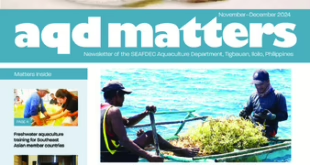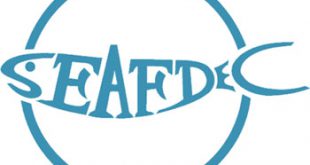| Navicula + abalone mucus = high metamorphosis |
| One of the major problems that have perplexed abalone hatchery operators is the poor settlement or the attachment and metamorphosis of abalone larvae. To increase the production of seeds needed for stock enhancement, suitable inducers for the settlement of abalone larvae have to be provided.
Since tests using different abalone species showed that responses to settlement cues vary depending on the species, Wenresti Gallardo and Shelah Mae Buen-Ursua of SEAFDEC/AQD decided to test the effect of larval settlement inducers on the tropical abalone Haliotis asinina.
Inducers tested included abalone mucus, Navicula sp., Navicula + mucus, mixed diatoms, and mixed diatoms + mucus. Variables requiring mucus were produced by allowing a juvenile abalone to crawl for one hour into treated Petri dishes, while the other samples that did not require the mucus were prepared using certain laboratory procedures. Four Petri dishes of each treatment and control were randomly placed on the bottom of each of the five 60-liter fiberglass tanks, which contained 30 liters of treated seawater. Larvae, which were stocked at 200 per liter, were counted and monitored during the experiment.
The three trials conducted had a common ground, wherein the type of settlement substrate had a significant effect on larval attachment. Of the five treatments used, abalone had greater attachment on mucus, Navicula, Navicula + mucus, and mixed diatoms + mucus on Day 1 of the study. By Days 3 and 7, the Navicula and Navicula + mucus treatments resulted in higher live abalone postlarvae compared to the other treatments. By Day 10, the Navicula + mucus treatment registered the highest number of fully metamorphosed postlarvae.
The authors think that the higher larval attachment to the samples mentioned above could be due to the abalone mucus, which acts as an attractant for larval attachments. Since mucus consists primarily of proteins and polysaccharides, this material, also produced by other marine gastropods like sea slugs, could have positive effects on abalone metamorphosis. It is also possible that the mucus secreted by Navicula has had a hand in the good results for Day 1. Furthermore, factors such as the uniform cells and prostate type of cell growth of Navicula make it a suitable attachment. Although Navicula was the dominant species in the mixed-diatom treatment, the presence of three-dimensional species like Melosira, Thalassiothrix and Fragilaria may have prevented the attachment of the abalones, which suggests that being one-dimensional isn’t so bad if you’re a diatom. In addition, other researches have noted the high nutritional value of Navicula.
Given these results, the authors suggest that techniques for the mass culture of Navicula on settlement plates be developed, and that these be grazed by abalone juveniles to produce the best possible outcome.
Read more from the journal Aquaculture (2003) 221: 357-364 |
Check Also
2023 Releases
September-October 2023Download here — File Size: 7.85 Mb July-August 2023Download here — File Size: 5.17 …
 SEAFDEC/AQD Southeast Asian Fisheries Development Center | Aquaculture Department
SEAFDEC/AQD Southeast Asian Fisheries Development Center | Aquaculture Department

